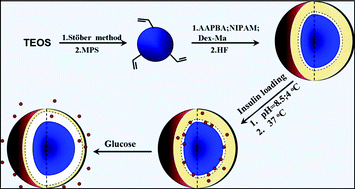Glucose- and temperature-responsive core–shell microgels for controlled insulin release
Abstract
In this paper, a novel core–shell microgel was prepared based on poly(N-isopropylacrylamide-co-3-acrylamidophenylboronic acid-co-dextran-maleic acid) (p(NIPAM-co-AAPBA-co-Dex-Ma)) coated silica nanoparticles via radical polymerization. The core–shell microgels presented glucose- and temperature-sensitivity, and the shell thickness could be easily regulated by the molar ratio of the comonomers. The polymer shell was active in drug loading as it underwent a distinct transition from a swollen state to a collapsed state as the temperature increased. Insulin was applied as a model drug and the behaviors of insulin loading/release were investigated. The insulin loading was temperature-dependent and up to 20%. The cumulative release of insulin in vitro showed that insulin release was dependent on glucose concentration. The glucose sensitivity of the microgels could be adjusted simply by adjusting the pH. The cytotoxicity assay indicated that the core–shell microgels have good biocompatibility. These results showed that the core–shell microgels have potential for a controlled insulin release system.


 Please wait while we load your content...
Please wait while we load your content...